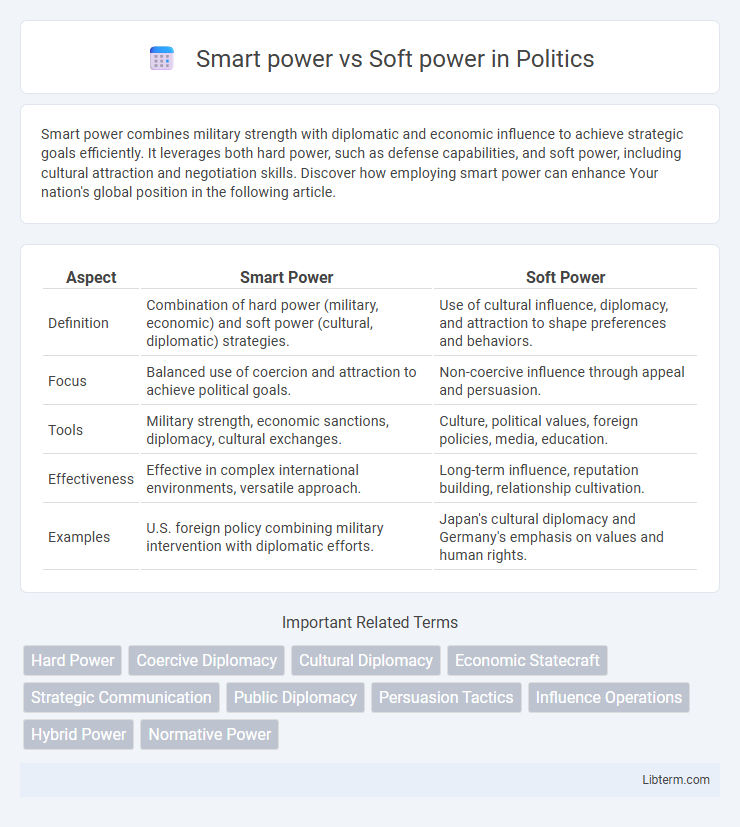Smart power combines military strength with diplomatic and economic influence to achieve strategic goals efficiently. It leverages both hard power, such as defense capabilities, and soft power, including cultural attraction and negotiation skills. Discover how employing smart power can enhance Your nation's global position in the following article.
Table of Comparison
| Aspect | Smart Power | Soft Power |
|---|---|---|
| Definition | Combination of hard power (military, economic) and soft power (cultural, diplomatic) strategies. | Use of cultural influence, diplomacy, and attraction to shape preferences and behaviors. |
| Focus | Balanced use of coercion and attraction to achieve political goals. | Non-coercive influence through appeal and persuasion. |
| Tools | Military strength, economic sanctions, diplomacy, cultural exchanges. | Culture, political values, foreign policies, media, education. |
| Effectiveness | Effective in complex international environments, versatile approach. | Long-term influence, reputation building, relationship cultivation. |
| Examples | U.S. foreign policy combining military intervention with diplomatic efforts. | Japan's cultural diplomacy and Germany's emphasis on values and human rights. |
Understanding Smart Power and Soft Power
Smart power integrates the strategic use of both hard power, such as military force, and soft power, including cultural influence and diplomacy, to achieve foreign policy objectives. Soft power emphasizes attraction through cultural appeal, political values, and foreign policies that inspire approval and cooperation from other nations. Understanding the balance between these approaches enables countries to effectively navigate international relations by combining coercion and persuasion.
Origins and Evolution of Soft Power
Soft power, a concept coined by political scientist Joseph Nye in the late 1980s, refers to the ability of a country to persuade others through cultural influence, political values, and diplomacy rather than coercion or payment. Originating from the need to understand power dynamics during the Cold War, soft power evolved as a strategic complement to traditional hard power, emphasizing attraction and legitimacy in international relations. Over time, nations have increasingly leveraged soft power tools such as media, education, and cultural exchange programs to enhance their global influence without resorting to military force.
Defining the Concept of Smart Power
Smart power integrates the strategic use of both hard power, such as military force and economic sanctions, and soft power, including diplomacy, cultural influence, and international cooperation. It emphasizes a balanced approach to achieve foreign policy objectives by leveraging the strengths of coercion and attraction. This concept highlights the importance of adapting tactics to specific geopolitical contexts for effective global influence.
Key Differences Between Smart Power and Soft Power
Smart power integrates both hard power, such as military and economic coercion, and soft power, which involves cultural influence and diplomacy, to achieve foreign policy objectives effectively. Soft power relies primarily on attraction through cultural appeal, political values, and foreign policies rather than coercion or payment, emphasizing persuasion and consent. The key difference lies in smart power's strategic combination of coercion and attraction, whereas soft power depends solely on non-coercive means to shape international relations.
Strategic Applications in International Relations
Smart power in international relations combines military strength and diplomatic influence, leveraging both hard and soft tactics to achieve strategic objectives such as conflict resolution and alliance building. Soft power relies on cultural diplomacy, economic incentives, and ideological appeal to shape preferences and foster cooperation among nations without coercion. Strategic applications of smart power include multilateral negotiations and targeted sanctions, while soft power is crucial in public diplomacy and international aid programs that enhance a country's global reputation.
Case Studies: Soft Power Success Stories
Japan's use of soft power in promoting anime and technology has significantly enhanced its global influence and cultural appeal, creating strong international partnerships. South Korea's investment in K-pop and cinema has transformed its cultural exports into powerful tools for economic growth and diplomatic engagement. Sweden's emphasis on innovation, design, and humanitarian aid has successfully elevated its global standing and fostered positive international relations.
Case Studies: Smart Power in Action
The United States' approach in the Asia-Pacific region exemplifies smart power by combining military alliances with cultural diplomacy and economic aid to counterbalance China's influence. South Korea's strategy integrating hard power through military readiness and soft power via the Korean Wave (Hallyu) showcases effective smart power deployment in reinforcing national security and global image. India's use of smart power is evident in its technological partnerships and peacekeeping missions, leveraging both strategic defense capabilities and positive diplomatic engagement.
Limitations and Criticisms of Each Approach
Smart power faces limitations due to its reliance on the effective integration of both hard military capabilities and soft diplomatic influence, which can lead to inconsistent outcomes when either element is weak or contradictory. Soft power is criticized for being insufficient alone in confronting aggressive states or crises, as its non-coercive nature often lacks the immediate impact required for enforcement or deterrence. Both approaches struggle with measuring success concretely, as soft power effects are diffuse and long-term, while smart power's dual strategy may dilute resources and create conflicting priorities.
Future Trends in Global Power Dynamics
Future trends in global power dynamics indicate a growing interplay between smart power, which combines military strength and diplomatic negotiation, and soft power, characterized by cultural influence and economic partnerships. Nations are increasingly leveraging technological innovation, cyber capabilities, and global connectivity to enhance smart power, while simultaneously investing in cultural diplomacy, education, and global governance to expand their soft power reach. This dual emphasis on smart and soft power shapes the evolving landscape of international relations, emphasizing adaptability and multifaceted influence in the 21st century.
Balancing Smart Power and Soft Power for Effective Diplomacy
Balancing smart power, which combines military strength and economic influence, with soft power, characterized by cultural appeal and diplomatic persuasion, is crucial for effective diplomacy. Nations that adeptly integrate these strategies can project authority while fostering cooperation, enhancing global influence without resorting to coercion. Effective use of smart and soft power together strengthens international partnerships and advances national interests more sustainably.
Smart power Infographic

 libterm.com
libterm.com